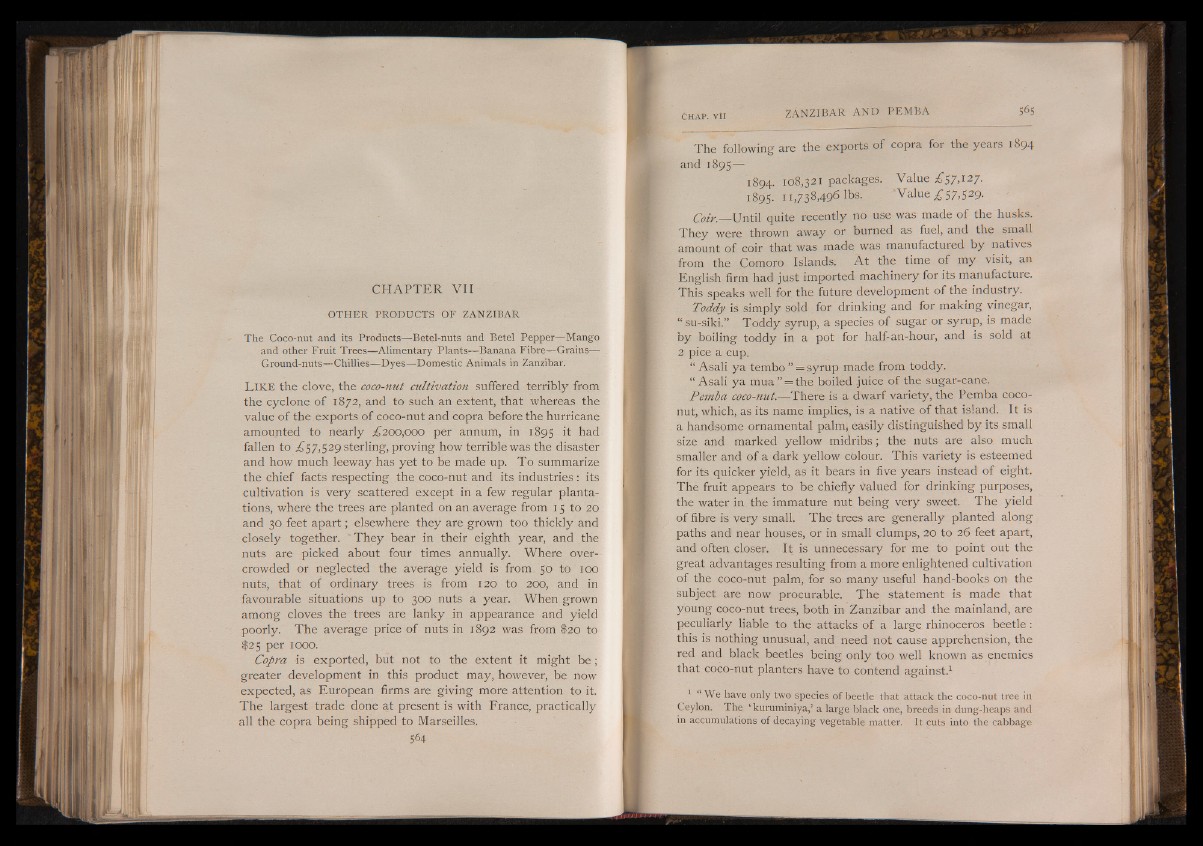
CH A P T ER VII
OTHER PRODUCTS OF ZANZIBAR
The Coco-nut and its Products— Betel-nuts and Betel Pepper— Mango
and other Fruit Trees— Alimentary Plants— Banana Fibre— Grains—
Ground-nuts—Chillies— Dyes— Domestic Animals in Zanzibar.
L IK E the clove, the coco-nut cultivation suffered terribly from
the cyclone of 1872, and to such an extent, that whereas the
value of the exports of coco-nut and copra before the hurricane
amounted to nearly £200,000 per annum, in 1895 it had
fallen to ¿57,529 sterling, proving how terrible was the disaster
and how much leeway has yet to be made up. To summarize
the chief facts respecting the coco-nut and its industries : its
cultivation is very scattered except in a few regular plantations,
where the trees are planted on an average from 15 to 20
and 30 feet apart; elsewhere they are grown too thickly and
closely together. ' They bear in their eighth year, and the
nuts are picked about four times annually. Where overcrowded
or neglected the average yield is from 50 to 100
nuts, that of ordinary trees is from 120 to 200, and in
favourable situations up to 300 nuts a year. When grown
among cloves the trees are lanky in appearance and yield
poorly. The average price of nuts in 1892 was from $20 to
$25 per 1000.
Copra -is exported, but not to the extent it might b e ;
greater development in this product may, however, be now
expected, as European firms are giving more attention to it.
The largest trade done at present is with France, practically
all the copra being shipped to Marseilles.
5 6 4
The following are the e x p o r t s of copra fo r th e years 1894
and 1895—
1894. 108,321 packages. Value ¿57,127.
1895. 11,738,496 lbs. 'Value ¿57,529.
Coir. Until quite recently no use was made of the husks.
They were thrown away or burned as fuel, and the small
amount of coir that was made was manufactured by natives
from the Comoro Islands. A t the time of my visit, an
English firm had just imported machinery for its manufacture.
This speaks well for the future development of the industry.
Toddy is simply sold for drinking and for making vinegar,
“ su-siki.” Toddy syrup, a species of sugar or syrup, is made
by boiling toddy in a pot for half-an-hour, and is sold at
2 pice a cup.
“ Asali ya tembo ” = syrup made from toddy.
“ Asali ya mua” = the boiled juice of the sugar-cane.
Pemba coco-nut.—/There is a dwarf variety, the Pemba coconut,
which, as its name implies, is a native of that island. It is
a handsome ornamental palm, easily distinguished by its small
size and marked yellow midribs; the nuts are also much
smaller and of a dark yellow colour. This variety is esteemed
for its quicker yield, as it bears in five years instead of eight.
The fruit appears to be chiefly Valued for drinking purposes,
the water in the immature nut being very sweet. The yield
of fibre is very small. The trees are generally planted along
paths and near houses, or in small clumps, 20 to 26 feet apart,
and often closer. It is unnecessary for me to point out the
great advantages resulting from a more enlightened cultivation
of the coco-nut palm, for so many useful hand-books on the
subject are now procurable. The statement is made that
young coco-nut trees, both in Zanzibar and .the mainland, are
peculiarly liable to the attacks of a large rhinoceros beetle:
this is nothing unusual, and need not cause apprehension, the
red and black beetles being only too well known as enemies
that coco-nut planters have to contend against.1
1 “ We have only two species of beetle that attack the coco-nut tree in
Ceylon. The ‘ kuruminiya,’ a large black one, breeds in dung-heaps and
in accumulations of decaying vegetable matter. It cuts into the cabbage